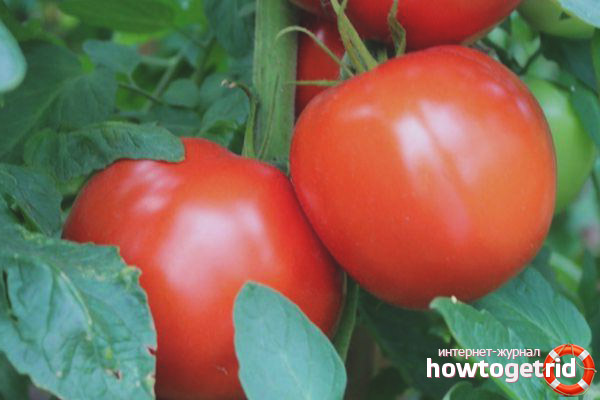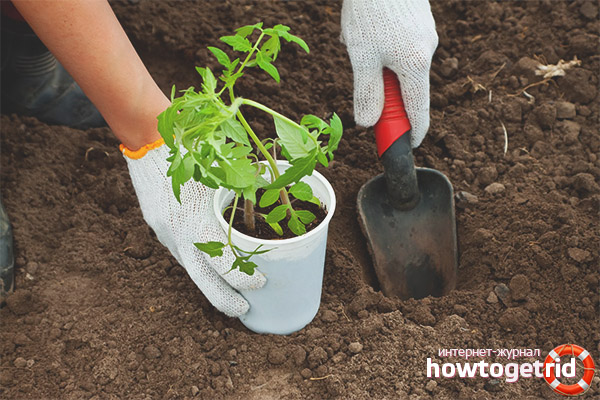The content of the article
Tomato Townsville is planted and grown in the open air and in greenhouses in almost all regions of Russia. Due to its resistance to any weather conditions, the variety has become widespread in cold Siberia and the northern regions. Tomatoes ripen almost simultaneously, which is very convenient for harvesting.
Description and specifications
- Townsville refers to hybrid early ripe varieties (ripen in 100-110 days).
- The height of the bush is 90-150 centimeters.
- Oblivion is average, the leaves are large, light green, slightly corrugated, the surface is slightly corrugated.
- Productivity - about 9 kilograms per square meter.
Fruit:
- Ripen early.
- The shape of the tomatoes is flat round with ribs.
- Weight - from 150 to 250 grams.
- The fruit is four-chambered.
- Bright red color.
- The skin is smooth and thick, which allows you to transport vegetables without harming them.
- The taste is sour, tomato flavor.
Agricultural technology
After 5-7 days, when the seeds hatch, the film needs to be removed and placed boxes with seedlings where there is a lot of light - for example, on a window. The first 7 days after the sprouts appear, it is necessary to maintain a temperature of about 16 degrees, and then increase to 20-23 degrees.
After the second leaf is formed in the plant, the seedlings dive - that is, they each plant in their own capacity. As containers, you can use plastic cups - they are very convenient to deliver to the landing site.
During a dive, it is better to shorten the central root - this will serve as an incentive for the formation of new roots. At the end of the dive, the seedlings are watered with water at room temperature.
Transfer to a permanent place
Transplant seedlings need at the end of May, when the weather is established and the frost ends. The site is better to choose on the sunny side - the variety loves when there is a lot of light. In no case should not be planted where last year sick tomatoes, otherwise these vegetables will get sick. Well, if earlier on this place grew cucumbers, root crops or cabbage.
The soil must first be plowed (in the fall) about 30-35 centimeters and some organic matter added there - cow dung, bird droppings. During planting, a little compost is introduced into the holes, seedlings are planted and sprinkled with earth, and then watered.
Cultivation and care
Care for tomatoes consists in timely watering, cultivation and weeding. Watering is carried out 4-5 times a week in the morning and evening hours, when the sun is not too hot. After it, the soil is tedious to constantly loosen, otherwise a hard earth crust will form on the surface that does not allow oxygen to pass to the roots.
So that there are no weeds, the soil must be constantly weeded, destroying all the vegetation that takes the necessary food from the soil from the plants. It is also recommended to mulch the soil using black fiber - it will provide drip irrigation, oxygen access to the roots of the plant and will not allow weeds to develop. You can still mulch with straw, plucked grass and leaves, then the tomatoes will have additional sources of nutrition.
As soon as the plant reaches the maximum height, and the fruits begin to ripen, the bushes must be tied up, otherwise the plants may break due to the severity of the fruits.And gardeners need to remember that the ovaries formed at the end of summer do not ripen, but only take away from the ripening tomatoes the substances necessary for nutrition. Therefore, it is better to cut off unnecessary flowers mercilessly, so that there is a good harvest.
Top dressing
Diseases and Pests
It has a high immunity, most diseases bypass this variety, even those formidable and terrible for many, like fusarium and verticillosis. But when it is discovered that the plant is sick (leaves are damaged or yellowed), it is necessary to conduct treatment with special preparations. Against pests, you also need to use insecticides, spraying them with bushes.
Using
Tomatoes are consumed fresh directly from the bush, used in salads, good juices are made from them, ketchups and sauces are made. Vegetables are also rolled up in jars for winter and eaten in winter.
Video: how often and how much to water tomatoes?











Submit